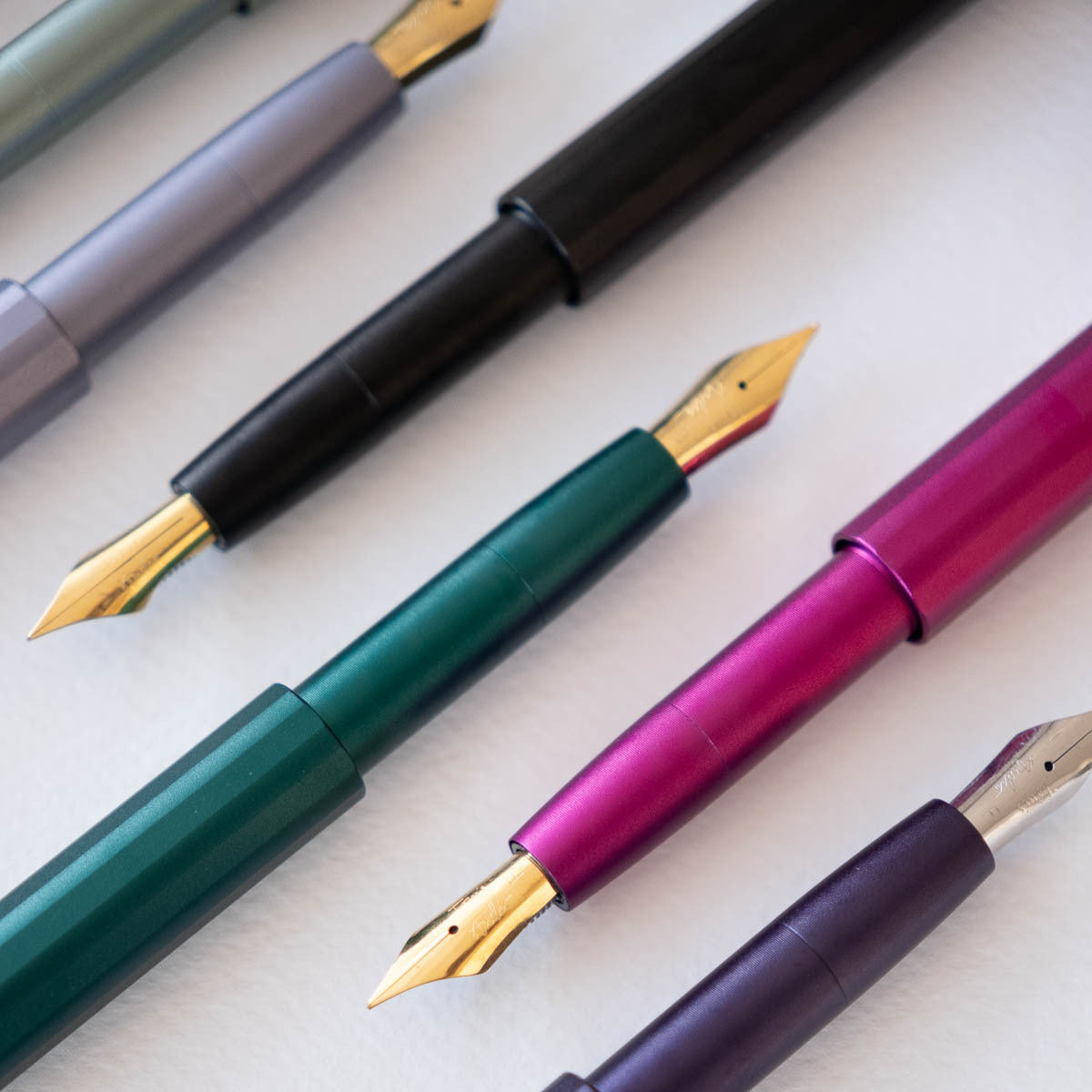The Pocket Fountain Pen
A brief guide to get you started with your new pen.

ABOUT THE STUDIO POCKET FOUNTAIN PEN
Our Studio Fountain Pen is crafted from anodised aluminium.
- Length capped – 100mm
- Length uncapped – 70mm
- Pen barrel diameter – 10mm
- Weight – 25g
Absolutely! Our Studio Pocket Fountain Pen works beautifully for left-handed users. However, as with most fountain pens, smudging can occur depending on your writing style.
Fountain pen nibs are usually ready to use straight away. If you notice any ink flow issues, we recommend giving your pen a flush with warm soapy water or using our Nib Cleaning Solution for best results.
For tips, check out our visual guide and video tutorial.
We recommend MD Paper for its smooth finish and fountain pen-friendly qualities – it prevents bleeding and ensures your lines are crisp and clear.
Tom is always striving to refine his designs based on customer feedback, and as a result, the Studio Pocket Pen is now even more, well, pocket-friendly! By carefully adjusting the proportions, its size has been reduced by 12mm when fully posted, creating a pen that’s perfectly compact for on-the-go use while still feeling wonderful in hand.
ALL ABOUT INKS
Our Studio Pocket Fountain Pen works beautifully with all fountain pen inks, and you’ll find a splendid selection here.
Avoid using calligraphy-specific ink though, as it can clog the pen.
Yes, you can! The Gold and Sterling Silver plated nibs resist corrosion, so it’s safe to leave ink in the pen.
The Pro-Flex nib, however, is prone to corrosion. For the best longevity, we recommend either removing the Pro-Flex nib and drying it between uses or flushing the pen with distilled water after each use and drying it thoroughly.
The Studio Pocket Pen comes with an international size ink cartridge, ink converter and a syringe attachment. You can use the ink converter and syringe to fill up your cartridge when you’ve used all the ink inside.
- Flush out the used cartridge with water and let dry.
- Attach the ink converter and syringe together.
- Insert syringe end into your ink bottle.
- Draw up ink by twisting the ink converter.
- Transfer the syringe into your empty ink cartridge and twist the converter to let the ink out.
Yes! An eye-dropper pen utilises the entire barrel of the pen as an ink reservoir. Before filling the body with ink, make sure to grease the threads of your pen to prevent any leaks. You can find a helpful video on how to do this here.
The Studio Pocket pen fits an international size short ink cartridge and can be refilled for multiple uses. You can find some replacement ink cartridges on our site here.
ALL ABOUT NIBS
Each nib has unique qualities and so if you’re unsure which nib is best for you, take a look at our handy nib guide to help you decide.
All our nib units unscrew from the pen for easy swapping. To change nibs:
- Remove the ink cartridge.
- Hold the nib unit (nib and feed: the black part under the nib) between your fingers.
- Twist anti-clockwise to unscrew the nib unit.
Paper acts as a natural abrasive, so with regular use, the nib will polish itself over time.
If you’d like to speed up the process, you can use micromesh – a fine abrasive that goes up to 12,000 grit. Carefully sand the iridium tip of the nib, starting with a lower grit (1200–2400) and work your way up for a buttery-smooth writing experience.
CARING FOR YOUR STUDIO POCKET FOUNTAIN PEN
We recommend thoroughly flushing your fountain pen before its first use. This removes any manufacturing oils on the nib that could hinder ink flow. You can use:
- Nib Cleaning Solution
- Distilled water
- Water with a small drop of dish soap
TROUBLESHOOTING
There might be dirt, grease, or dried ink on the nib. To fix this, soak the nib in warm, soapy water for a few minutes, rinse thoroughly, and reassemble the pen with the cartridge.
Air bubbles trapped in the ink converter can also disrupt ink flow. To resolve this, hold the pen upright so the air rises to the top, then gently twist the cartridge clockwise to push the air out.
There are a few reasons why your pen might be leaking:
- Ensure you're not blocking the tiny hole on the side of the lid when pulling it off.
- Check that the nib housing is firmly screwed into the body of the pen.
- If you’re using your pen as an eye-dropper, make sure all the threads are thoroughly lubricated with silicone grease to prevent leaks.
